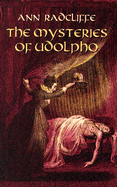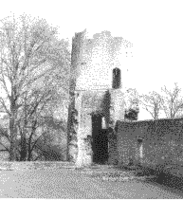


regency style and just in time for Hallowe’en…the gothic novel, a very popular genre that began in 1764 with the publication of The Castle of Otranto by Hugh Walpole, and ended in 1820 with Melmoth the Wanderer by Charles Maturin.
The influence of the gothic novel is still with us today; its elements creep into films and novels, and the contemporary “gothic romance” is enjoying a comeback. So what is it about gothics people liked (then and now), other than a good scare and the idea of the TSTL heroine creeping around dark passages and wearing only her nightie?
They feature exotic, often Italian settings, sinister castles and abbeys–something very popular in the regency era , when landowners commissioned picturesque ruins and follies to grace their landscape. As well as the good scare, they have a strong moral twist of justice done and wrongs avenged, with one or two people, usually the hero/heroine or a narrator (like Robert Walton, the narrator of Mary Shelley’s Frankenstein), who lives to tell the tale, and with whom we can identify. In some cases, as in Wuthering Heights, the matter-of-fact tone of the narrator (Mr. Lockwood) serves to strengthen the supernatural elements; if a twit like Mr. Lockwood can hear the ghostly Cathy at the window, then it must be true. The monsters, real or imagined, are instruments of justice or revenge, like Frankenstein’s monster, or Conan Doyle’s hound in Hound of the Baskervilles, written in 1902 but drawing strongly on the gothic tradition.
I have a soft spot for gothics since the hero of my book Dedication, Adam Ashworth, publishes gothic novels under the name of Mrs. Ravenwood, and I had a lot of fun creating purple passages to head each chapter. I based most of them on the work of the gothic novelist I know best, Mrs. Ann Radcliffe. She published bestsellers beginning with The Mysteries of Udolpho (1794), skewered by Jane Austen’s Northanger Abbey. The scene where Catherine explores an ancient chest and finds a laundry list is pure gothic pastiche. And remember the horrid veil?
Ah yes, the horrid veil.
If you’ve read Udolpho (it’s still in print) you’ll certainly remember the scene where the heroine discovers the veil and draws it aside (she’s creeping around a secret passage at the time, having been kidnapped to a mysterious castle) and swoons in horror at what she sees. It’s a tremendously effective scene. Every time she remembers it, which is fairly often, there’s a frisson of terror. And so on through the book. You’re still wondering. The references to the horrid veil become less frequent toward the end and you begin to wonder if Mrs. R has forgotten about it. Oh, surely not. Because if you were a character in a gothic who was denied such knowledge you know you’d go mad, or go into a nunnery, or have to pretend to be a ghost or some such. Then, when you’ve almost given up hope, Mrs. R. delivers, sort of. Busy tidying up the odds and ends of the novel, she reveals, in one throwaway sentence, that what the heroine saw behind the veil was the wax effigy of a worm-ridden corpse. Huh? I believe there’s a reason for the wax effigy being there–possibly a warning for visitors to keep out of the secret passage–you couldn’t expect the owner of a castle in a gothic to do anything sensible like post a “Keep Out” or “Servants Only” sign.
OK, enough from me. What do you like about gothic elements? Have you used them in your books? What gothic-influenced novels do you like? Could you write one with a straight face?
Janet

I read Udolpho once, and really didn’t understand the appeal! It was very long and slow; heroine was a ditz; hero was helpless and cried a lot; and nothing much happened. 🙂
I was never a big fan of the 60’s/70’s style of Gothic romance, either. I think my psyche works a different way.
I do love “Jane Eyre,” though, and when I read “Rebecca” as a fifteen-year-old I loved it too (though looking at it now, I think it’s SO LONG! I don’t remember that much plot!)
Gothic plays were very popular during the Regency, too, I’ve found. There was even one called THE VAMPYRE… 🙂
Cara
I just love the creepy elements, not to mention the alpha heroes (I mean, have I mentioned that lately? Oh, and that I like wearing the color black? Okay, good.). I used to read Mary Stewart and Victoria Holt books Back In The Day, and I just recently bought Rebecca. Haven’t read it yet, though.
I’m a big Hitchcock fan and I had fond memories of the movie of Rebecca, until I saw it again after a 15-year hiatus. And I hated it. Slow, tedious, super-wimpy heroine, Laurence Olivier barking thru his moustache and so, so stiff upper-lip, and the truly awful Hollywood interpretation of Cornwall, Spanish moss and all. Apparently Hitchcock wanted to film it in location in Cornwall but couldn’t find anything that matched his vision. A real shame. It’s sometimes a real gamble to revisit something you once loved. That’s why I probably won’t read Georgette Heyer again.
In answer to my own question, no, I probably couldn’t write a gothic. I tried one in a half-hearted sort of way once, and the hero turned up on a bicycle and with a cockney accent.
Of course another appeal of gothics was the sex (I restrained myself in my original post). All that being captured and restrained by a tall, dark, forbidding guy who gets all stern when you him meet in your nightie (I mean of course that he’s not wearing the nightie unless it’s a cutting edge sort of gothic). Oooh. Madam, you are my prisoner…
Janet
Funny! I’m revisiting some of my comfort books on audiotape. This week is Mary Stewart’s The Ivy Tree.
I had to read Udolpho for school and found it tough going. I found The Monk a lot more fun. I remember this big distinction between between terror (oooooh! scary!) and horror (ooooooh! gross!) with, we were told, Ann Radcliffe being a proponent of the former and Matthew Lewis a proponent of the latter. I was pleasantly surprised by how modern and matter of fact the language of The Monk was in contrast to the flowery Udolpho (or the whiplash Otranto!
But the gothic is a wonderful thing, silly as 18th and 19th century gothics read now. Without gothic what would Jane Austen mock? Where would the tension of Sense and Sensibility go?
And, Cara, there’s some fabulous old gothics out there, just as good as regencies! Mary Stewart, of course, and Jill Tattersall (you can’t beat a name like Jill Tattersall!), those early Anne Stuart books, Barbara Michaels, Elsie Lee, Madeleine Brent. I could probably re-read Merlin’s Keep a few more times yet.
Back when I worked in the bookstore in the early 80s I remember attempts to distinguish between gothics and romantic suspense. Although I think it was all a marketing ploy (gothics were for old people, romantic suspense were for hip, young people) for me the distinction was between dippy herione in a nightgown and clever heroine (still in a nightgown, of course!)
In the gothic vein, though, I loved Sarah Smith’s The Vanished Child. The hero wore the nightgown there! Metaphorically speaking . . . The Baron Alexander von Reisden went mad after his young wife died, and in five years he had not got himself sane. His friends were concerned about him. He had tried suicide once, early on, and had not succeeded; this was encouraging in a man who was usually both well-prepared and lucky…. He still had the gun, in a box in his top drawer behind his collar studs, and he still suffered from what had led him to the act, his singular and inexplicable and apparently incurable madness.
I loved REBECCA and JANE EYRE, also enjoyed Victoria Holt and some others, so I do like a well-written story with Gothic elements.
I backed into writing one myself, sort of by accident. SAVING LORD VERWOOD was the last of a trilogy. The hero appeared in the first book and I needed a county to put his estate in and chose Cornwall somewhat at random (I was really preoccupied getting that story to work first). Then when it was time to write SLV I thought it was time to take a crack at a mystery element, so I thought how fun it would be if persons unknown were trying to kill the hero.
Pretty soon I had the classic story of the bride married to a man with secrets arriving at a lonely manor near some lovely cliffs. By the time I’d hung someone off the cliff (couldn’t believe I did that!) I realized I had a pretty Gothic book on my hands.
But at least Pen never ran around in her nightie.
Elena 🙂
Hi, Heather! Well, if you would recommend one Elsie Lee (or one old Anne Stuart Gothic) for a Gothic-shy reader (me) to try, which would it be? 🙂
Cara
Oh, I remember Gothics! Read a lot of them when I was a kid, especially Victoria Holt. I liked the creepy/spooky elements, like Megan, and the dark, mysterious heroes. Wasn’t so crazy about the (mostly) idiot heroines. And I loved DuMaurier’s Jamaica Inn. But I haven’t read one in ages and ages. I might, if there was a good new one. And I might write one, too, but it would have to be Gothic-with-a-difference. Whatever that might be. 🙂
For some reason I never really got into Victoria Holt or Dorothy Eden (although both are authors who come immediately to mind when I think gothic!) I know I read a few, but I never liked the “hero is married to a madwoman we must kill off” plot (which I seem to recall was a Dorothy Eden staple) and Victoria Holt just never grabbed me.
My favorite old Anne Stuart is probably Camerson’s Landing although I also loved all of her Candlelight Regencies.
As far as Elsie Lee goes. I think I’ve read Season of Evil about ten times, but I’m not quite sure I’d call it a gothic . . .
I keep meaning to read Jamaica Inn! I caught part of a movie version of it during a summer “tour” of the southwest with my mother as a teenager and still remember my journal note about the “horse theiving brother” having possibilities!
Okay, Heather, I’ll try one!
I forgot to mention, I read “Castle of Otranto” too, and thought it was very strange! Bizarre, almost farcical. But I don’t expect Walpole meant it that way. 🙂
(Oh look, now I have a little photo too! Just like Elena and Bertie. Well, maybe Bertie’s isn’t exactly a photo, but you get the idea!)
(By the way, Bertie, I hope you don’t mind me calling you Bertie! It’s Saturday night, and I’m feeling daring!)
(You know, my photo looks a little dark. Don’t know if I can do anything about that. What does everyone think? Too dark?)
(Hey, let’s see if I can go for the world record for paragraphs in a row, all in separate quote marks!)
Cara